Characterizing the Effect of Ocean Surface Currents on Advanced Scatterometer (ASCAT) Winds Using Open Ocean Moored Buoy Data
Abstract
:1. Introduction
2. Data and Methods
3. Results
3.1. Effect of Surface Current on Satellite Wind
3.2. Correction of Scatterometer-Derived Ocean Surface Wind Speed
4. Discussions
5. Conclusions
Author Contributions
Funding
Data Availability Statement
Acknowledgments
Conflicts of Interest
References
- Bailey, K.; Steinberg, C.; Davies, C.; Galibert, G.; Hidas, M.; McManus, M.A.; Murphy, T.; Newton, J.; Roughan, M.; Schaeffer, A. Coastal mooring observing networks and their data products: Recommendations for the next decade. Front. Mar. Sci. 2019, 6, 180. [Google Scholar] [CrossRef]
- Bôas, A.B.V.; Ardhuin, F.; Ayet, A.; Bourassa, M.A.; Brandt, P.; Chapron, B.; Cornuelle, B.D.; Farrar, J.T.; Fewings, M.R.; Fox-Kemper, B.; et al. Integrated observations and modeling of global winds, currents, and waves: Requirements and challenges for the next decade. Front. Mar. Sci. 2019, 6, 425. [Google Scholar] [CrossRef]
- Brown, R.A.; Cardone, V.J.; Guymer, T.; Hawkins, J.; Overland, J.E.; Pierson, W.J.; Peteherych, S.; Wilkerson, J.C.; Woiceshyn, P.M.; Woiceshyn, P.M. Surface wind analyses for SEASAT. J. Geophys. Res. Ocean 1982, 87, 3355–3364. [Google Scholar] [CrossRef]
- Lin, H.; Xu, Q.; Zheng, Q. An overview on SAR measurements of sea surface wind. Prog. Nat. Sci. 2008, 18, 913–919. [Google Scholar] [CrossRef]
- Yang, X.; Li, X.; Pichel, W.G.; Li, Z. Comparison of ocean surface winds from ENVISAT ASAR, MetOp ASCAT scatterometer, buoy measurements, and NOGAPS model. IEEE Trans. Gosci. Remote Sens. 2011, 49, 4743–4750. [Google Scholar] [CrossRef]
- Yin, X.; Wang, Z.; Song, Q.; Huang, Y.; Zhang, R. Estimate of ocean wind vectors inside tropical cyclones from polarimetric radiometer. IEEE J. Sel. Top. Appl. Earth Obs. Remote Sens. 2017, 10, 1701–1714. [Google Scholar] [CrossRef]
- Zhang, B.; Mouche, A.; Lu, Y.; Perrie, W.; Zhang, G.; Wang, H. A Geophysical Model Function for Wind Speed Retrieval from C-Band HH-Polarized Synthetic Aperture Radar. IEEE Geosci. Remote Sens. Lett. 2019, 16, 1521–1525. [Google Scholar] [CrossRef]
- Bourassa, M.A.; Meissner, T.; Cerovecki, I.; Chang, P.S.; Dong, X.; De Chiara, G.; Donlon, C.; Dukhovskoy, D.S.; Elya, J.; Fore, A.; et al. Remotely sensed winds and wind stresses for marine forecasting and ocean modeling. Front. Mar. Sci. 2019, 6, 443. [Google Scholar] [CrossRef]
- Cornillon, P.; Park, K. Warm core ring velocities inferred from NSCAT. Geophys. Res. Lett. 2001, 28, 575–578. [Google Scholar] [CrossRef]
- Dickinson, S.; Kelly, K.A.; Caruso, M.J.; McPhaden, M.J. Comparisons between the TAO buoy and NASA scatterometer wind vectors. J. Atmos. Ocean. Technol. 2001, 18, 799–806. [Google Scholar] [CrossRef]
- Kelly, K.A.; Dickinson, S.; McPhaden, M.J.; Johnson, G.C. Ocean currents evident in satellite wind data. Geophys. Res. Lett. 2001, 28, 2469–2472. [Google Scholar] [CrossRef]
- Kelly, K.A.; Dickinson, S.; Johnson, G.C. Comparisons of scatterometer and TAO winds reveal time-varying surface currents for the tropical Pacific Ocean. J. Atmos. Ocean. Technol. 2005, 22, 735–745. [Google Scholar] [CrossRef]
- Plagge, A.M.; Vandemark, D.; Chapron, B. Examining the impact of surface currents on satellite scatterometer and altimeter ocean winds. J. Atmos. Ocean. Technol. 2012, 29, 1776–1793. [Google Scholar] [CrossRef]
- McGregor, S.; Sen Gupta, A.; Dommenget, D.; Lee, T.; McPhaden, M.J.; Kessler, W.S. Factors influencing the skill of synthesized satellite wind products in the tropical Pacific. J. Geophys. Res. Ocean. 2017, 122, 1072–1089. [Google Scholar] [CrossRef]
- Vogelzang, J.; Stoffelen, A.; Verhoef, A.; Figa-Saldana, J. On the quality of high-resolution scatterometer winds. J. Geophys. Res. 2011, 116, C10033. [Google Scholar] [CrossRef]
- Bentamy, A.; Fillon, D.C. Gridded surface wind fields from Metop/ASCAT measurements. Int. J. Remote Sens. 2012, 33, 1729–1754. [Google Scholar] [CrossRef]
- Paiva, V.; Kampel, M.; Camayo, R. Comparison of multiple surface ocean wind products with buoy data over blue amazon (Brazilian continental margin). Adv. Meteorol. 2021, 6680626. [Google Scholar] [CrossRef]
- Fairall, C.W.; Bradley, E.F.; Hare, J.E.; Grachev, A.A.; Edson, J.B. Bulk parameterization of air–sea fluxes: Updates and verification for the COARE algorithm. J. Clim. 2003, 16, 571–591. [Google Scholar] [CrossRef]
- Rio, M.-H.; Mulet, S.; Picot, N. Beyond GOCE for the ocean circulation estimate: Synergetic use of altimetry, gravimetry, and in situ data provides new insight into geostrophic and Ekman currents. Geophys. Res. Lett. 2014, 41, 8918–8925. [Google Scholar] [CrossRef]
- Bentamy, A.; Fillon, D.C.; Perigaud, C. Characterization of ASCAT measurements based on buoy and QuikSCAT wind vector observations. Ocean. Sci. 2008, 4, 265–274. [Google Scholar] [CrossRef]
- Nonaka, M.; Xie, S.-P. Covariations of sea surface temperature and wind over the Kuroshio and its extension: Evidence for ocean-to-atmosphere feedback. J. Clim. 2003, 16, 1404–1413. [Google Scholar] [CrossRef]
- Song, X. The importance of including sea surface current when estimating air-sea turbulent heat fluxes and wind stress in the Gulf Stream region. J. Atmos. Ocean. Technol. 2021, 38, 119–138. [Google Scholar] [CrossRef]
- Hu, D.; Wu, L.; Cai, W.; Gupta, A.S.; Ganachaud, A.; Qiu, B.; Gordon, A.L.; Lin, X.; Chen, Z.; Hu, S.; et al. Pacific western boundary currents and their roles in climate. Nature 2015, 522, 299–308. [Google Scholar] [CrossRef]
- Sterl, M.F.; Delandmeter, P.; van Sebille, E. Influence of barotropic tidal currents on transport and accumulation of floating microplastics in the global open ocean. J. Geophys. Res. Ocean. 2020, 125, e2019JC015583. [Google Scholar] [CrossRef]
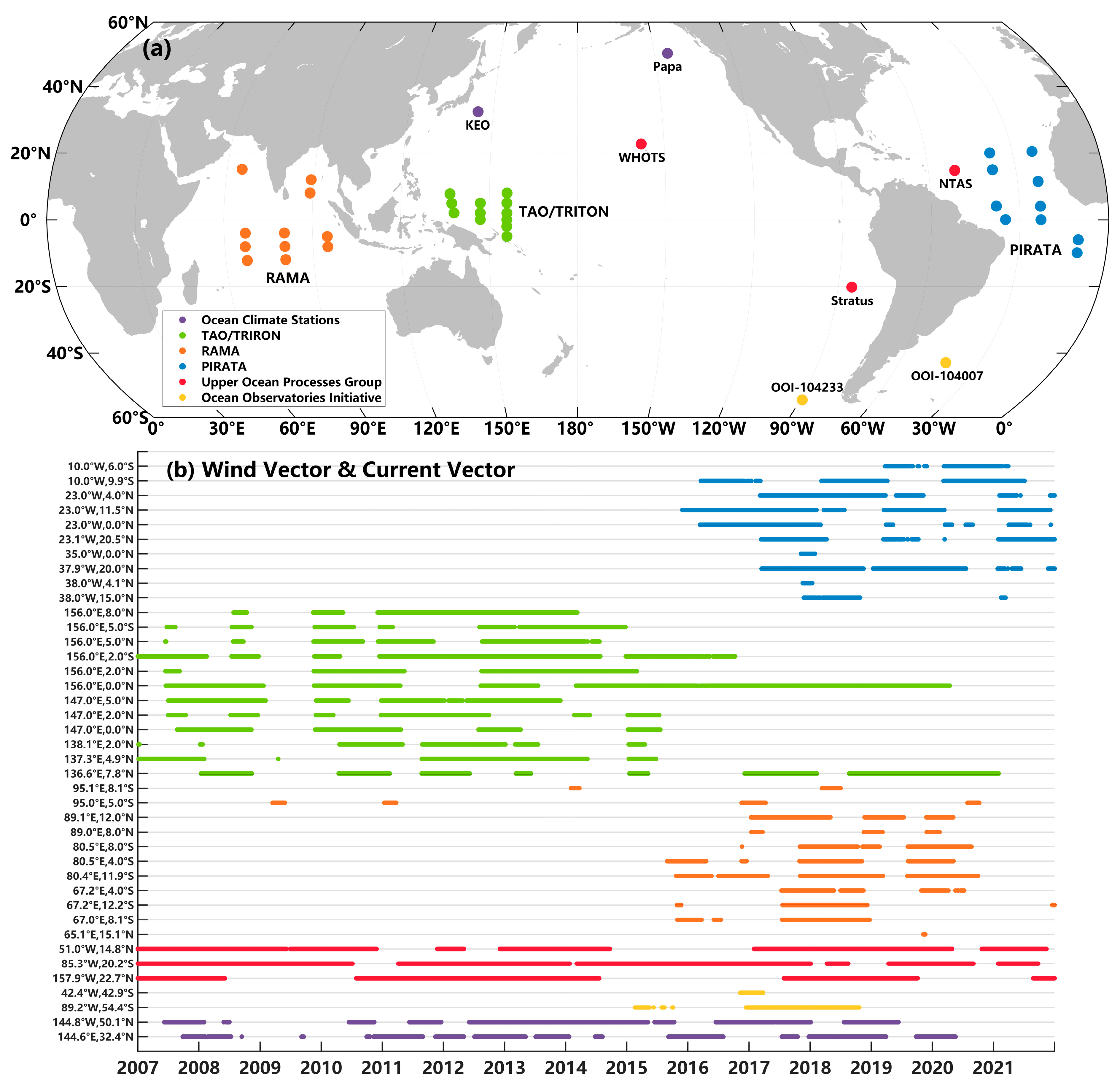


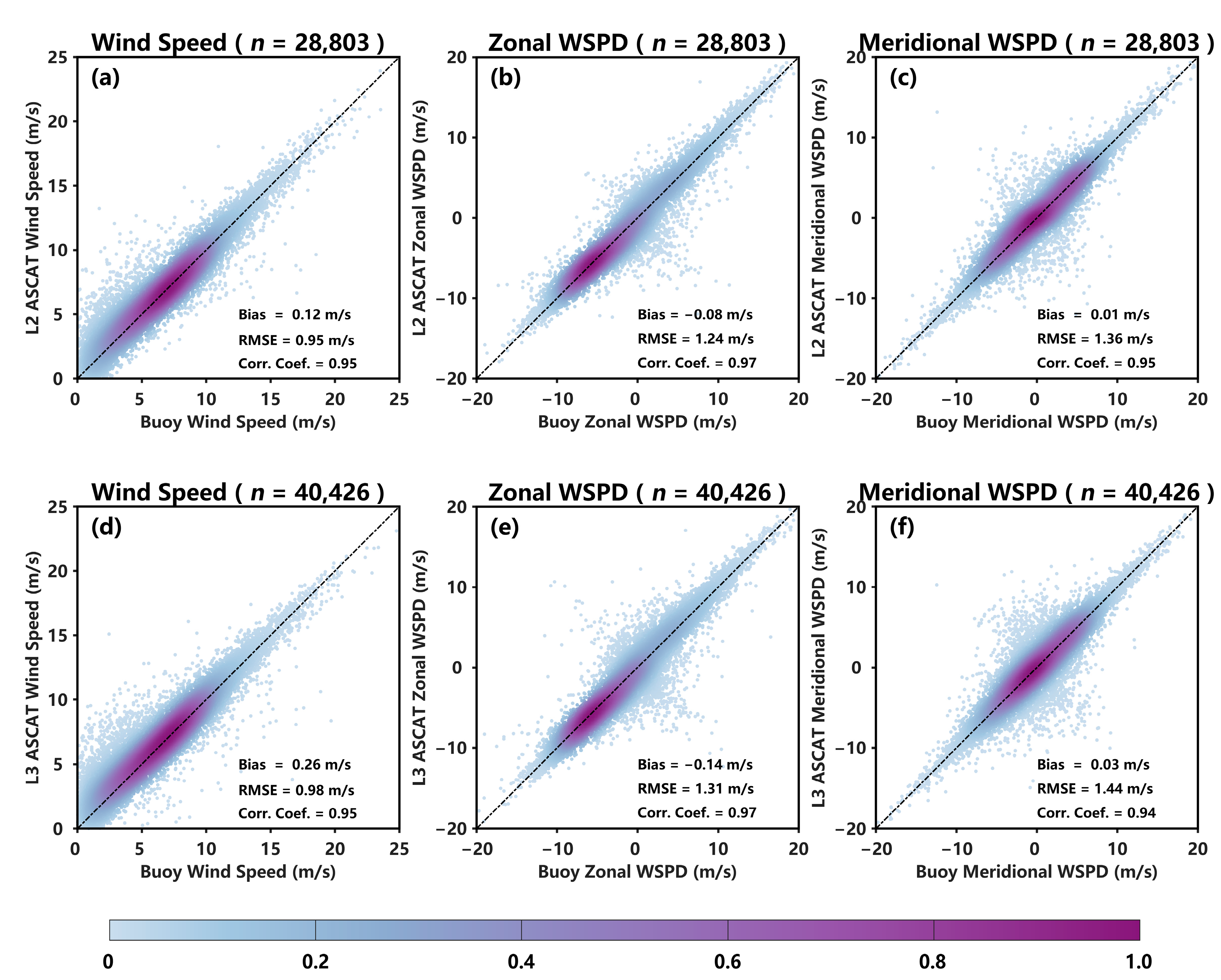



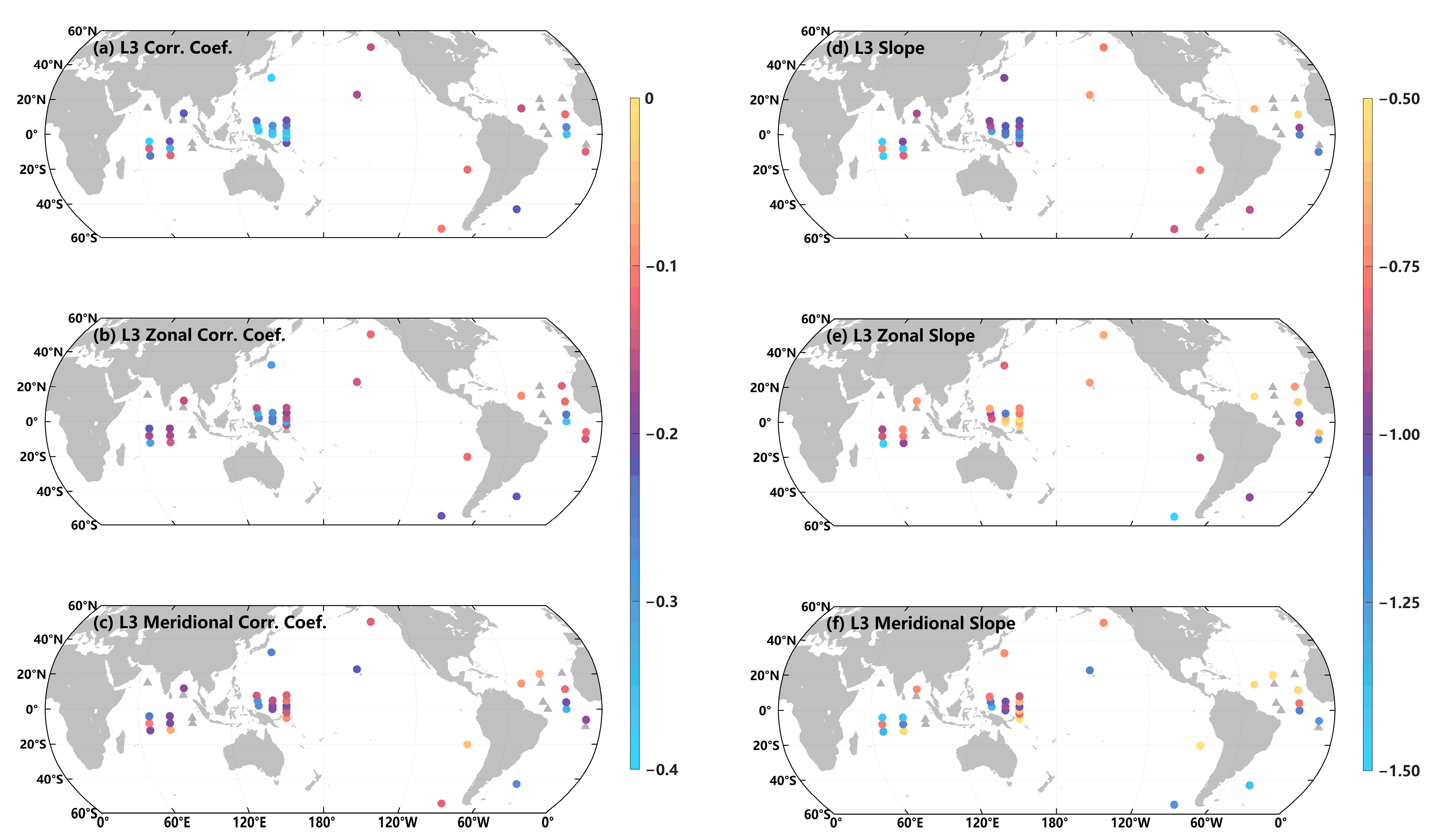
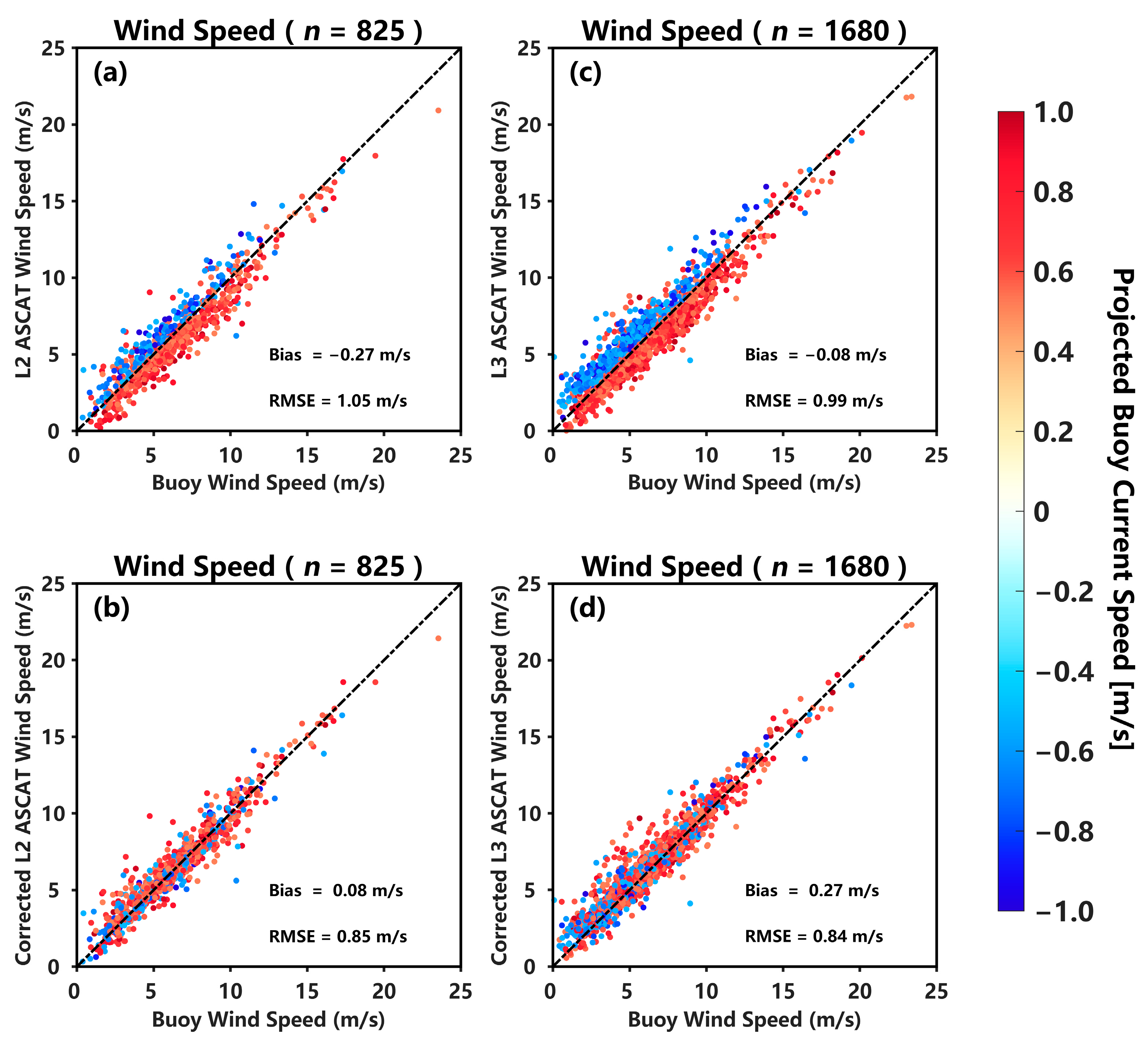

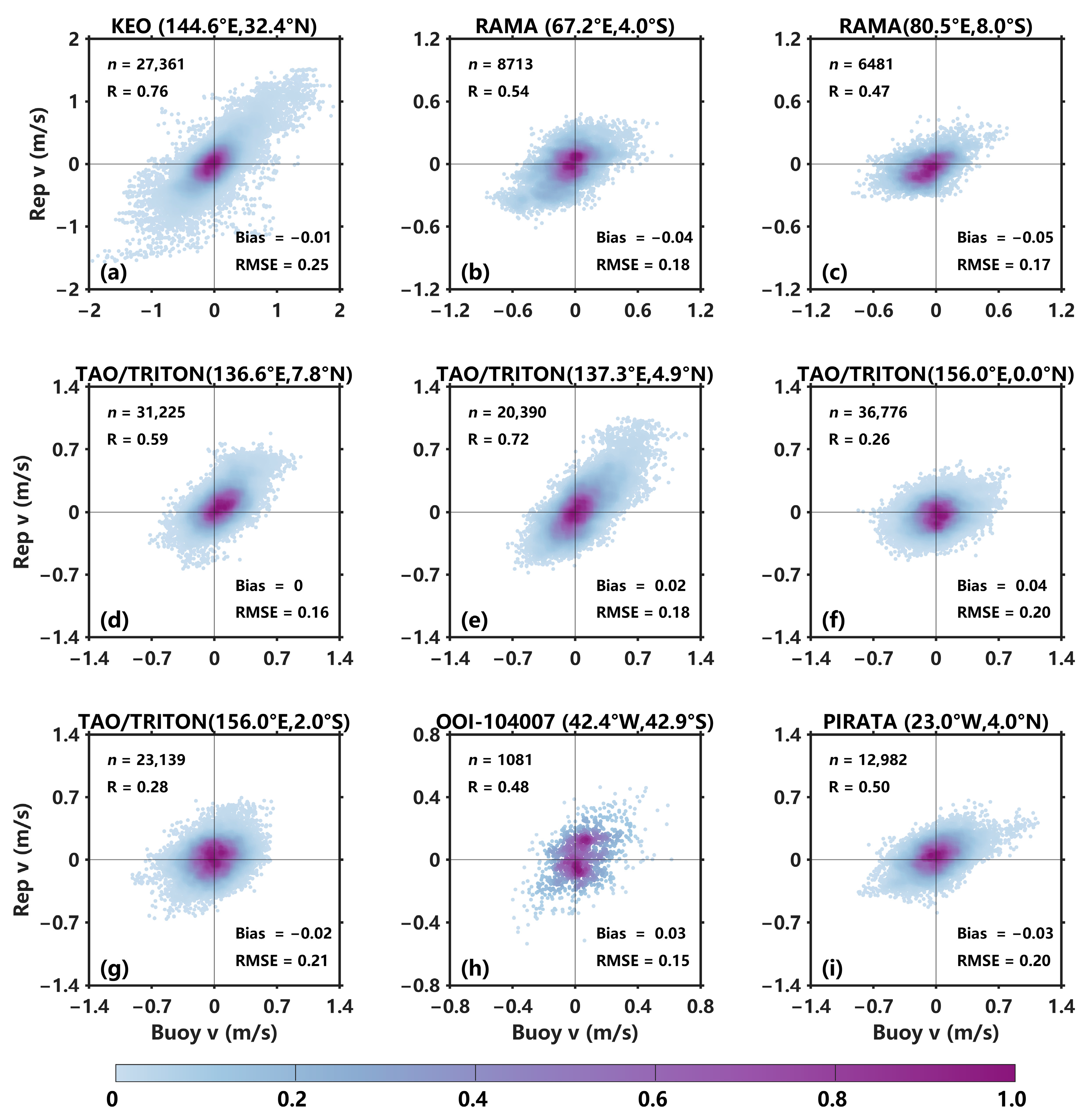


| Buoy ID | Longitude | Latitude | Depth | Sensor Type |
|---|---|---|---|---|
| KEO | 144.6°E | 32.4°N | 5 m, 6 m, 8 m, 11.5 m, 15 m, and 15.6 m at different deployment durations | Sontek, TRDI Doppler volume sampler and Nortek Aquadopp current meter at different deployment durations |
| Papa | 144.8°W | 50.1°N | 5 m, 6 m, and 15 m at different deployment durations | Sontek, TRDI Doppler Volume Sampler and Nortek Aquadopp Current Meter at different deployment durations |
| OOI-104233 | 89.2°W | 54.4°S | 12 m | Single-point velocity meter |
| OOI-104007 | 42.4°W | 42.9°S | 12 m | Single-point velocity meter |
| WHOI-WHOTS | 157.9°W | 22.7°N | 10 m | Vector measuring current meter |
| WHOI-Stratus | 85.3°W | 20.2°S | 7 m, 10 m, 13 m 15 m, and 20 m at different deployment durations | Aanderaa ADCM, NORTEK ADCM, and Aanderaa RCM11 at different deployment durations |
| WHOI-NTAS | 51.0°W | 14.8°N | 5.7 m, 6 m, 12 m, and 13 m at different deployment durations | Aquadopp current meter, NORTEK ADCM, and NORTEK current meter at different deployment durations |
| RAMA | 65.1°E | 15.1°N | 12 m | Sontek |
| 67.0°E | 8.1°S | |||
| 67.2°E | 12.2°S | |||
| 67.2°E | 4.0°S | |||
| 80.4°E | 11.9°S | |||
| 80.5°E | 4.0°S | |||
| 80.5°E | 8.0°S | |||
| 89.0°E | 8.0°N | |||
| 89.1°E | 12.0°N | |||
| 95.0°E | 5.0°S | 10 m | ||
| 95.1°E | 8.1°S | |||
| TAO/TRITON | 136.6°E | 7.8°N | 10 m | Sontek |
| 137.3°E | 4.9°N | |||
| 138.1°E | 2.0°N | |||
| 147.0°E | 0.0°N | |||
| 147.0°E | 2.0°N | |||
| 147.0°E | 5.0°N | |||
| 156.0°E | 0.0°N | |||
| 156.0°E | 2.0°N | |||
| 156.0°E | 2.0°S | |||
| 156.0°E | 5.0°N | |||
| 156.0°E | 5.0°S | |||
| 156.0°E | 8.0°N | |||
| PIRATA | 38.0°W | 15.0°N | 12 m | Sontek |
| 38.0°W | 4.1°N | |||
| 37.9°W | 20.0°N | |||
| 35.0°W | 0.0°N | |||
| 23.1°W | 20.5°N | |||
| 23.0°W | 0.0°N | |||
| 23.0°W | 11.5°N | |||
| 23.0°W | 4.0°N | |||
| 10.0°W | 9.9°S | |||
| 10.0°W | 6.0°S |
Disclaimer/Publisher’s Note: The statements, opinions and data contained in all publications are solely those of the individual author(s) and contributor(s) and not of MDPI and/or the editor(s). MDPI and/or the editor(s) disclaim responsibility for any injury to people or property resulting from any ideas, methods, instructions or products referred to in the content. |
© 2023 by the authors. Licensee MDPI, Basel, Switzerland. This article is an open access article distributed under the terms and conditions of the Creative Commons Attribution (CC BY) license (https://creativecommons.org/licenses/by/4.0/).
Share and Cite
Cheng, T.; Chen, Z.; Li, J.; Xu, Q.; Yang, H. Characterizing the Effect of Ocean Surface Currents on Advanced Scatterometer (ASCAT) Winds Using Open Ocean Moored Buoy Data. Remote Sens. 2023, 15, 4630. https://doi.org/10.3390/rs15184630
Cheng T, Chen Z, Li J, Xu Q, Yang H. Characterizing the Effect of Ocean Surface Currents on Advanced Scatterometer (ASCAT) Winds Using Open Ocean Moored Buoy Data. Remote Sensing. 2023; 15(18):4630. https://doi.org/10.3390/rs15184630
Chicago/Turabian StyleCheng, Tianyi, Zhaohui Chen, Jingkai Li, Qing Xu, and Haiyuan Yang. 2023. "Characterizing the Effect of Ocean Surface Currents on Advanced Scatterometer (ASCAT) Winds Using Open Ocean Moored Buoy Data" Remote Sensing 15, no. 18: 4630. https://doi.org/10.3390/rs15184630
APA StyleCheng, T., Chen, Z., Li, J., Xu, Q., & Yang, H. (2023). Characterizing the Effect of Ocean Surface Currents on Advanced Scatterometer (ASCAT) Winds Using Open Ocean Moored Buoy Data. Remote Sensing, 15(18), 4630. https://doi.org/10.3390/rs15184630







